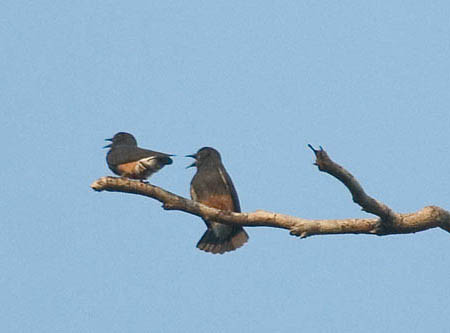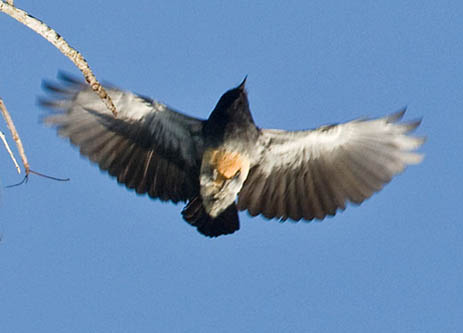
a web page by Don Roberson |
PUFFBIRDS Bucconidae |
||
|
||
Despite the fine plumage, "preparers of specimens have noted that many puffbird species are malodorous ... indeed, since 1815 it has been known that puffbirds are not especially edible, and perhaps their oft-remarked confiding and imperturbable natures ... is related to this circumstances. On the other hand, their unpleasant odour could simply be a result of the type of prey that they ingest, which would have a side benefit of making them undesirable as prey themselves;" Rasmussen & Collar (2002). White-whiskered Puffbird is well-known as a bad-smelling species to handle. Its prey includes army ants — and it may join bird flocks that are following army ants (Willis 1982) — and coral snakes (Smith 1969).
|
||
I remember being very impressed with my first close encounter with a largish and impressive puffbird: this Black-breasted Puffbird along Pipeline Road in Panama back in 1981 (right). It also has haunting vocalizations, as do many puffbirds. Black-breasted is actually the mid-sized black-and-white puffbird in lowland and foothill forests in Panama. The larger species is White-necked — shown farther down the page — while the small species is Pied Puffbird (just below, left). These 3 species are in genus Notharchus, most of which have black-and-white plumage, but many puffbirds are patterned in a coordinated palette of brown, gray, and chestnut. Chestnut-capped Puffbird (below right in a nice photo by Arthur Grosset), in genus Bucco, is a beautifully patterned small puffbirds that lives in the subcanopy of the western Amazon Basin. |
||
|
||
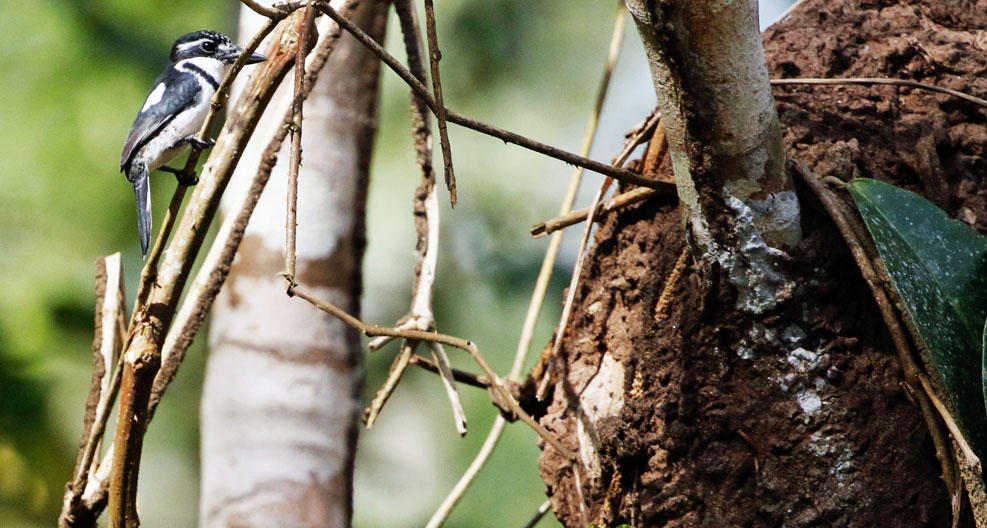 |
||
All puffbirds in genera Notharchus and Bucco nest in holes that they excavate in arboreal termitarium (Winkler et al. 2020). Pied Puffbird nests are tunnels dug in termitarium from 4–25 m above ground, up in the sub-canopy. One of the adults from the prior photo of Pied Puffbirds is shown at its presumed nesting termitarium — the puffbird (above) is dwarfed by the huge termite colony.
Barred Puffbird (below) is also a quiet bird. It inhabits the borders of lowland forest and second growth within its restricted range in eastern Panama, northwestern Colombia, and western Ecuador. They sit motionless for long periods of time at the mid-story level, only occasionally sallying out to snag insects. This lack of activity makes them difficult to spot. I know this from experience. We spent a lot of time looking in a relatively open woodland in eastern Panama, but did not spot the sitting pair until one was detected by voice: a low, drawn-out wolf-whistle. |
||
 |
||
The prey of many puffbirds routinely includes lizards, larger insects, centipedes, millipedes, and scorpions. Except for Swallow-winged Puffbird (see below), the "hunting technique is standard throughout the family. The birds make flycatcher-like sallies from an open perch ... and target prey that is amid green foliage, on trunks and branches, on the ground or in the air" (ibid.). A number of puffbirds have prominent facial bristles, but it is thought these help keep prey like bees and wasps out of their eyes, rather than being an aid in capturing prey (Winkler et al. 2020). |
||
Many puffbirds are actually quite small, but White-necked Puffbird (above, perched high in a Costa Rican forest next to a huge bromeliad), in genus Notharchus, is quite large. Based on weight, Nystalus puffbirds such as Barred or White-eared are less than half the size of a big Notharchus puffbird. Yet the small Pied Puffbird, discussed above and also in genus Notharchus, is just a third of the size of White-necked Puffbird. There are ten genera in the Bucconidae. Five of these include Notharchus and Nystalus puffbirds, and others, shown and discussed above. Then there are two genera of nunbirds, one of which is black-robed, that sit quietly along the edges of many Neotropical lowland forests.
The White-faced Nunbird Hapaloptila castanea is quite different. It is not black but brownish above, chestnut below, black-billed, and has large white nasal tufts. Unlike most other bucconids it is a montane species, occurring patchily in cloud forest above 1500m (over 5000'). Despite this sign on a trail near Owlet Lodge, northern Peru, we dipped despite daily efforts.
|
||
The six species of nunlets (genus Nonnula) are also small and retiring in behavior. While, for example, Rusty-breasted Nunlet Nonnula rebecula "is widely reported as being rare, on basis of very low contact rates during fieldwork, but the species is probably under-recorded owing to unobtrusive habits" (Rasmussen & Collar 2002). Gray-cheeked Nunlet (right, in a very nice shot by Terence Degan), is restricted to eastern Panama and northwestern Colombia. It is not particularly shy but simply unobtrusive as it sits quietly at mid-canopy. |
||
Swallow-wing Puffbirds occur throughout the Amazon Basin and in other lowland forested areas from Venezuela to eastern Brazil. They nest by digging tunnels in sandy ground — often earthen banks, frequently along rivers — but have taken advantage of man-made strata such as airstrips or road cuts; Rasmussen & Collar (2002). Recent molecular evidence, matched to fossil deposits to estimate age, suggests that Swallow-wing Puffbird diverged from the rest of the Bucconidae about 18 million years ago (Prum et al. 2015). This could support subfamily assignment of this unique species. Indeed, there are many family-level clades among the passerines that are younger than this. |
||
|
||
Photos: The White-whiskered Puffbird Malacoptila panamensis was at Cerro Azul, Panama, on 17 Feb 2022. The Black-breasted Puffbird Notharchus pectoralis was along Pipeline Road, Panama, in Jan 1981. The pair of Pied Puffbird Notharchus tectus was near Lajas Blanca, Darién, Panama, on 13 Feb 2022; one of the adults is also shown next to it probable nesting termitarium in a following shot. Arthur Grosset photographed the Chestnut-capped Puffbird Bucco macrodactylus in Rondonia, Brazil, in March 2003. The White-eared Puffbird Nystalus chacuru was in Emas NP, Brazil, on 26 July 2010. The Barred Puffbird Nystalus radiatus was near Lajas Blanca, Darién, Panama, on 13 Feb 2022. The Spot-backed (Chaco) Puffbird Nystalus (maculatus) striatipectus was in the Brazilian Pantanal on 23 July 2010. The canopy-perched White-necked Puffbird Notharchus hyperrhynchus was at La Selva, Costa Rica, on 18 Dec 2007. Arthur Grosset photographed the White-fronted Nunbird Monasa morpoeus in Linhares, Espírito Santo, Brazil. The signpost at Owlet Lodge, Peru, was in Nov 2015. Terence Degan photographed the Gray-cheeked Nunlet Nonnula frontalis near the Rio Torti, Darién, Panama, on 11 Feb 2022. Arthur Grosset took all the photos of Swallow-winged Puffbird Chelidoptera tenebrosa in Brazil; the final two shots were from the Atlantic Forest population.
Bibliographic note: There is no "family book" but an excellent introduction to this family, with some great photos, is in Rasmussen & Collar (2002). Literature cited:
|
 The Puffbirds are a well-defined family of quiet forest birds in the lowlands of Central and South America. They vary in size from small to medium-sized landbirds and most have a large bulky head, large eyes, a robust bill, a bristly face, and loose plumage. Many species are beautifully patterned. This is White-whiskered Puffbird (left), a quiet bird of humid lowland forests from Mexico to Ecuador. Most adult puffbirds have similar plumages, but the rufous on the breast of this bird indicates it is a male. Its formal name is Malacoptila panamensis; this photo is from Panama.
The Puffbirds are a well-defined family of quiet forest birds in the lowlands of Central and South America. They vary in size from small to medium-sized landbirds and most have a large bulky head, large eyes, a robust bill, a bristly face, and loose plumage. Many species are beautifully patterned. This is White-whiskered Puffbird (left), a quiet bird of humid lowland forests from Mexico to Ecuador. Most adult puffbirds have similar plumages, but the rufous on the breast of this bird indicates it is a male. Its formal name is Malacoptila panamensis; this photo is from Panama.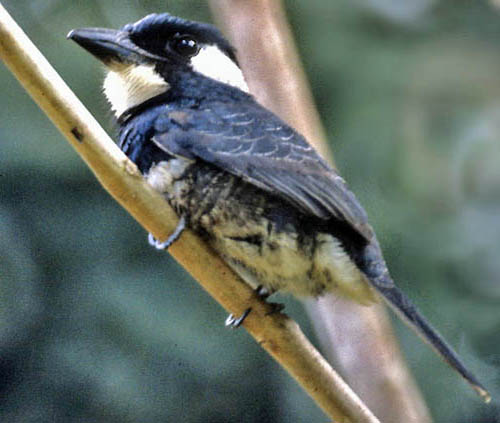 The closest relatives to Puffbirds are Jacamars [Galbulidae]; together they form the Order Galbuliformes. Puffbirds and jacamars are Neotropical sit-and-wait predators, but puffbirds have (mostly) short, broad bills while jacamars have (mostly) long, sharp-pointed bills. The two families diverged about 36 million years ago (Prum et al. 2015).
The closest relatives to Puffbirds are Jacamars [Galbulidae]; together they form the Order Galbuliformes. Puffbirds and jacamars are Neotropical sit-and-wait predators, but puffbirds have (mostly) short, broad bills while jacamars have (mostly) long, sharp-pointed bills. The two families diverged about 36 million years ago (Prum et al. 2015). 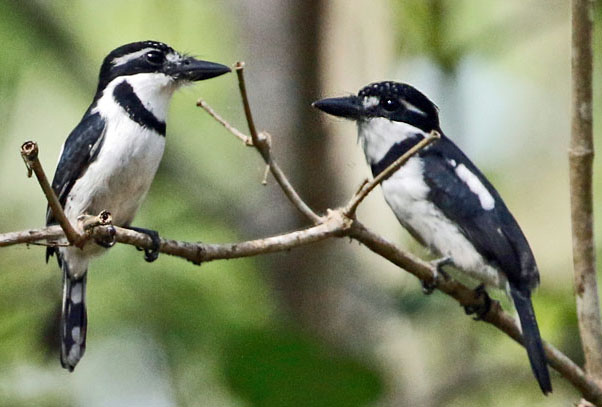

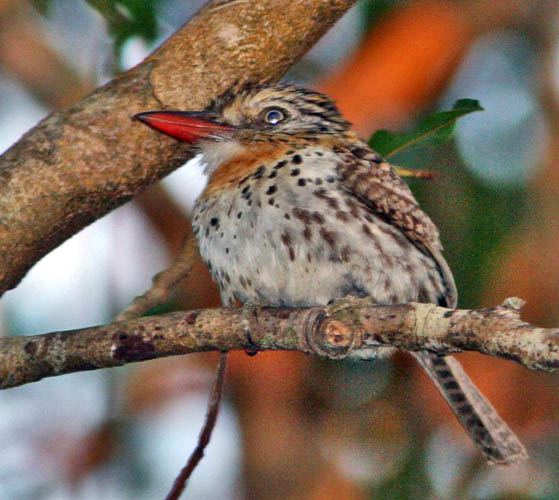 Puffbirds are among the quietest birds in Neotropical forests, and usually sing only at dawn or dusk. Some vocalize by opening their bill. This is not true of Spot-bellied Puffbird or its close relative, proposed as a split, the "Chaco Puffbird" of the Brazilian Pantanal (right). When they sing, it is open-billed. Yet, as they sit so quietly, they are still difficult to locate in mid-canopy. Spot-bellied and Barred Puffbird (below) are members of genus Nystalus. These puffbirds dig tunnels, but not in termitaria, but in a substrate like the rotting wood in a standing dead tree, or in a clay or sandy embankment (even a road-cut), or an underground chamber.
Puffbirds are among the quietest birds in Neotropical forests, and usually sing only at dawn or dusk. Some vocalize by opening their bill. This is not true of Spot-bellied Puffbird or its close relative, proposed as a split, the "Chaco Puffbird" of the Brazilian Pantanal (right). When they sing, it is open-billed. Yet, as they sit so quietly, they are still difficult to locate in mid-canopy. Spot-bellied and Barred Puffbird (below) are members of genus Nystalus. These puffbirds dig tunnels, but not in termitaria, but in a substrate like the rotting wood in a standing dead tree, or in a clay or sandy embankment (even a road-cut), or an underground chamber. 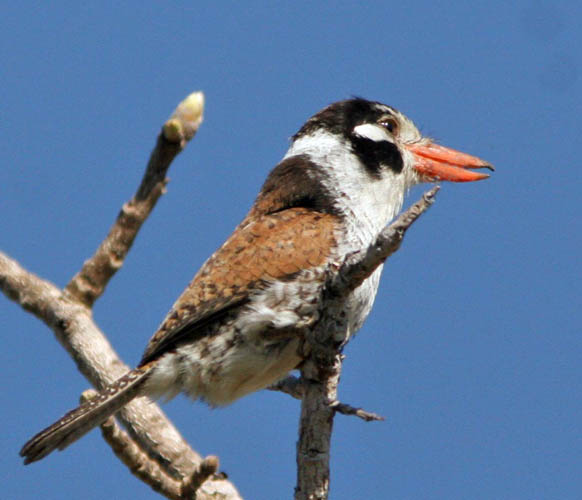 Many puffbirds are birds of dense tropical forests, but some species are adapted to more open habitats in gallery forests, cerrado, campos, or savanna. One example is the colorfully patterned White-eared Puffbird (left), also in genus Nystalus. It ranges from central Brazil to northern Argentina, "one of the southernmost distributions of any bucconid, and is reported to lower its body temperature and enter torpor during cool weather;" (Rasmussen & Collar 2002).
Many puffbirds are birds of dense tropical forests, but some species are adapted to more open habitats in gallery forests, cerrado, campos, or savanna. One example is the colorfully patterned White-eared Puffbird (left), also in genus Nystalus. It ranges from central Brazil to northern Argentina, "one of the southernmost distributions of any bucconid, and is reported to lower its body temperature and enter torpor during cool weather;" (Rasmussen & Collar 2002). Four nunbird species are in genus Monasa. They differ primarily in the presence of white on the crown or chin, or in the color of the bill. Three are red-billed and one is yellow-billed; the latter is Yellow-billed Nunbird Monasa flavirostris of the western Amazon. It is often considered rare or, at least, very unobtrusive This is White-fronted Nunbird (right; another Arthur Grosset photo). It is widespread in Central and South American lowlands, often at edges of clearings or sitting at mid-levels along rivers.
Four nunbird species are in genus Monasa. They differ primarily in the presence of white on the crown or chin, or in the color of the bill. Three are red-billed and one is yellow-billed; the latter is Yellow-billed Nunbird Monasa flavirostris of the western Amazon. It is often considered rare or, at least, very unobtrusive This is White-fronted Nunbird (right; another Arthur Grosset photo). It is widespread in Central and South American lowlands, often at edges of clearings or sitting at mid-levels along rivers.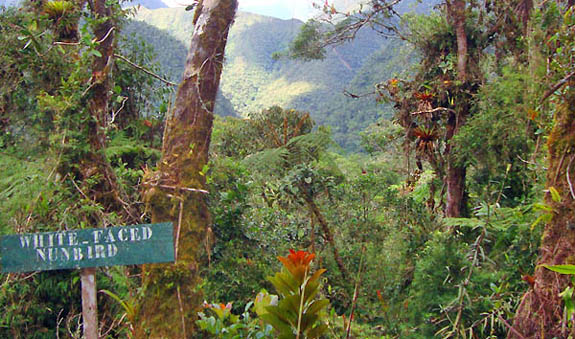
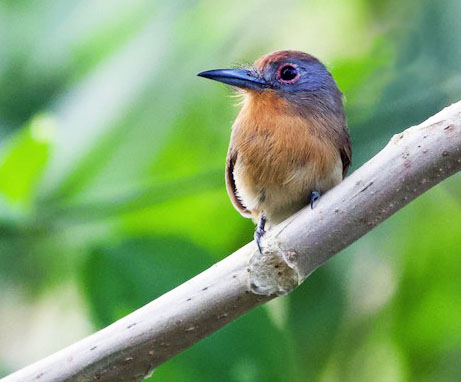 Two other genera are of small or tiny bucconids: nunlets (genus Nonnula) and the single species of monklet. The latter, Lanceolated Monklet Micromonacha lanceolata, is very patchily distributed at middle elevations in foothill forests from Costa Rica to Bolivia. It is the smallest member of the family, plus is elusive and hard to see. I've missed it several times, even when using a local guide, and by now I would very much like to see it.
Two other genera are of small or tiny bucconids: nunlets (genus Nonnula) and the single species of monklet. The latter, Lanceolated Monklet Micromonacha lanceolata, is very patchily distributed at middle elevations in foothill forests from Costa Rica to Bolivia. It is the smallest member of the family, plus is elusive and hard to see. I've missed it several times, even when using a local guide, and by now I would very much like to see it.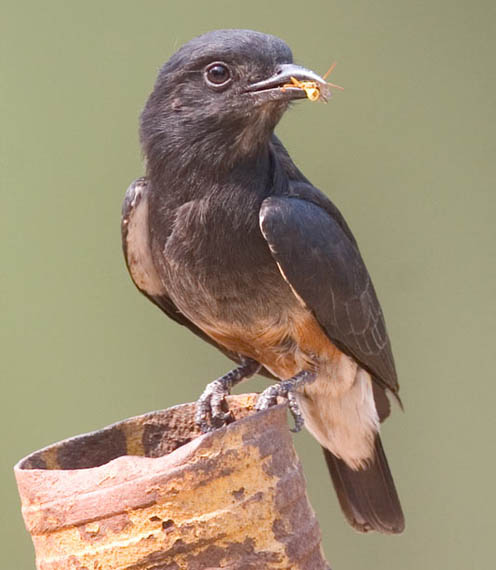 The final entry in the Bucconidae is a quite different bird. It is the Swallow-wing Puffbird or, more often in previous literature, just called "Swallow-wing" (left and below; all of these are Arthur Grosset photos). While most puffbirds prefer shade, even deep shade, Swallow-wing Puffbird sits out in the sun high on bare branches (below left). There are often along the banks of large rivers or high above the forest canopy. Here they sally out after fees, wasps, termites and flying ants. They have exceptionally broad wings and short tails. Global birders are apt to compare them to the wood-swallows of Australasia.
The final entry in the Bucconidae is a quite different bird. It is the Swallow-wing Puffbird or, more often in previous literature, just called "Swallow-wing" (left and below; all of these are Arthur Grosset photos). While most puffbirds prefer shade, even deep shade, Swallow-wing Puffbird sits out in the sun high on bare branches (below left). There are often along the banks of large rivers or high above the forest canopy. Here they sally out after fees, wasps, termites and flying ants. They have exceptionally broad wings and short tails. Global birders are apt to compare them to the wood-swallows of Australasia. 